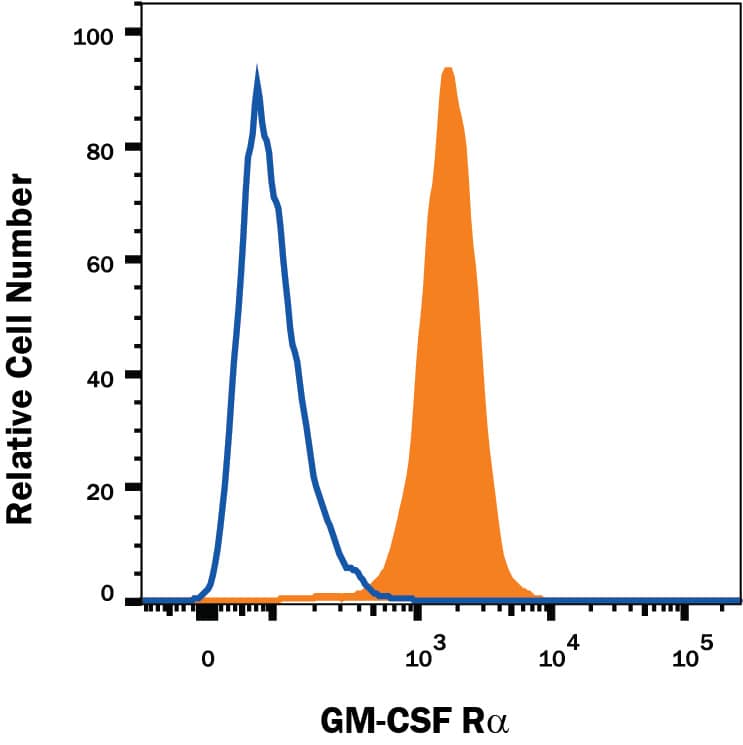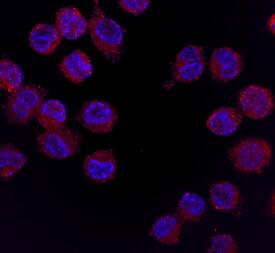Mouse GM-CSF R alpha Antibody
R&D Systems, part of Bio-Techne | Catalog # MAB6130


Key Product Details
Species Reactivity
Validated:
Cited:
Applications
Validated:
Cited:
Label
Antibody Source
Product Specifications
Immunogen
Leu30-Pro327
Accession # Q00941
Specificity
Clonality
Host
Isotype
Endotoxin Level
Scientific Data Images for Mouse GM-CSF R alpha Antibody
Cell Proliferation Induced by GM‑CSF and Neutralization by Mouse GM‑CSF R alpha Antibody.
Recombinant Mouse GM-CSF (Catalog # 415-ML) stimulates proliferation in the DA3 mouse myeloma cell line in a dose-dependent manner (orange line). Proliferation elicited by Recombinant Mouse GM-CSF (0.1 ng/mL) is neutralized (green line) by increasing concen-trations of Rat Anti-Mouse GM-CSF Ra Monoclonal Anti-body (Catalog # MAB6130). The ND50 is typically 0.02-0.12 µg/mL.Detection of GM-CSF R alpha in J774A.1 Mouse Cell Line by Flow Cytometry.
J774A.1 mouse reticulum cell sarcoma macrophage cell line was stained with Rat Anti-Mouse GM-CSF Ra Monoclonal Antibody (Catalog # MAB6130, filled histo-gram) or isotype control antibody (Catalog # MAB006, open histo-gram), followed by Allophy-cocyanin-conjugated Anti-Rat IgG Secondary Antibody (Catalog # F0113).GM‑CSF R alpha in J774A.1 Mouse Cell Line.
GM-CSF Ra was detected in immersion fixed J774A.1 mouse reticulum cell sarcoma macrophage cell line using Rat Anti-Mouse GM-CSF Ra Mono-clonal Antibody (Catalog # MAB6130) at 10 µg/mL for 3 hours at room temperature. Cells were stained using the NorthernLights™ 557-conjugated Anti-Rat IgG Secondary Antibody (red, upper panel; Catalog # NL013) and counterstained with DAPI (blue, lower panel). Specific staining was localized to cell surfaces and cytoplasm. View our protocol for Fluorescent ICC Staining of Cells on Coverslips.Applications for Mouse GM-CSF R alpha Antibody
CyTOF-ready
Flow Cytometry
Sample: J774A.1 mouse reticulum cell sarcoma macrophage cell line
Immunocytochemistry
Sample: Immersion fixed J774A.1 mouse reticulum cell sarcoma macrophage cell line
Neutralization
Formulation, Preparation, and Storage
Purification
Reconstitution
Formulation
Shipping
Stability & Storage
- 12 months from date of receipt, -20 to -70 °C as supplied.
- 1 month, 2 to 8 °C under sterile conditions after reconstitution.
- 6 months, -20 to -70 °C under sterile conditions after reconstitution.
Background: GM-CSF R alpha
Granulocyte macrophage colony stimulating factor receptor alpha (GM-CSF R alpha), also known as CD116, is a component of the receptor complex that mediates cellular responses to GM-CSF. GM-CSF promotes the differentiation and mobilization of granulocyte-macrophage, erythroid, megakaryocyte, and eosinophil progenitors. It enhances the activation of myeloid cell effector functions and plays a role in the development of Th1 biased immune responses, allergic inflammation, and autoimmunity (1-4). Mature mouse GM-CSF R alpha is an 80 kDa type I transmembrane glycoprotein that consists of a 298 amino acid (aa) extracellular domain (ECD) with two fibronectin type III domains and a juxtamembrane WSXWS motif, a 21 aa transmembrane segment, and a 40 aa cytoplasmic domain (5). Within the ECD, mouse GM-CSF R alpha shares approximately 33% and 58% aa sequence identity with human and rat GM-CSF R alpha, respectively. Soluble forms of the human receptor retain the ability to bind GM-CSF (6, 7). GM-CSF R alpha is expressed on hematopoietic stem cells, progenitor and differentiated cells in the myeloid lineage, vascular endothelial cells, placenta, and non‑hematopoietic solid tumor cells (8). GM-CSF R alpha associates with the common beta chain/CD131 ( betac), a 135 kDa transmembrane protein that is also the signal transducing component of the receptors for IL-3 and IL-5 (9, 10). Association with betac converts GM-CSF R alpha from a low affinity to a high affinity receptor for GM-CSF (9-11). The shared usage of betac underlies the synergism between GM-CSF, IL-3, and IL-5 in their effects on myeloid cell differentiation and activation (1, 2).
References
- Martinez-Moczygemba, M. and D.P. Huston (2003) J. Allergy Clin. Immunol. 112:653.
- Fleetwood, A.J. et al. (2005) Crit. Rev. Immunol. 25:405.
- Eksioglu, E.A. et al. (2007) Exp. Hematol. 35:1163.
- Cao, Y. (2007) J. Clin. Invest. 117:2362.
- Park, L.S. et al. (1992) Proc. Natl. Acad. Sci. 89:4295.
- Pelley, J.L. et al. (2007) Exp. Hematol. 35:1483.
- Raines, M.A. et al. (1991) Proc. Natl. Acad. Sci. 88:8203.
- Chiba, S. et al. (1990) Cell Regul. 1:327.
- Kitamura, T. et al. (1991) Proc. Natl. Acad. Sci. 88:5082.
- Hayashida, K. et al. (1990) Proc. Natl. Acad. Sci. 87:9655.
- Hoang, T. et al. (1993) J. Biol. Chem. 268:11881.
Long Name
Alternate Names
Gene Symbol
UniProt
Additional GM-CSF R alpha Products
Product Documents for Mouse GM-CSF R alpha Antibody
Product Specific Notices for Mouse GM-CSF R alpha Antibody
For research use only

